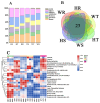Differences in the Quality Components of Wuyi Rock Tea and Huizhou Rock Tea
- PMID: 39796294
- PMCID: PMC11720515
- DOI: 10.3390/foods14010004
Differences in the Quality Components of Wuyi Rock Tea and Huizhou Rock Tea
Abstract
Different origins and qualities can lead to differences in the taste and aroma of tea; however, the impacts of origin and quality on the taste and aroma characteristics of Wuyi rock tea and Huizhou rock tea have rarely been studied. In this study, high-performance liquid chromatography (HPLC), gas chromatography-mass spectrometry (GC-MS), and sensory evaluation methods were used to compare the quality components of Wuyi rock tea and Huizhou rock tea. The sensory evaluation showed that they each have their own characteristics, but the overall acceptability of Wuyi rock tea is ahead of Huizhou rock tea (p < 0.01). Biochemical experiments showed that HT was the highest in water leachables, about 43.12%; WT was the highest in tea polyphenols, about 14.91%; WR was the highest in free amino acids, about 3.38%; and the six rock teas had different health benefits. High-performance liquid chromatography showed that the theanine contents of WS and WR were 0.183% and 0.103%, respectively, which were much higher than those of other varieties. The OPLS-DA model predicted the factors that caused their different tastes, in order of contribution: CG > ECG > caffeine > EGCG > theanine. Ten volatile substances with OAV ≥ 1 and VIP > 1 were also found, indicating that they contributed greatly to the aroma characteristics, especially hexanoic acid, hexyl ester, and benzyl nitrile. The results of the correlation analysis showed that theanine was significantly correlated with taste (p < 0.05), and hexanoic acid, hexyl ester, and benzyl nitrile were significantly correlated with smell (p < 0.05). Substances such as theanine, hexanoic acid, hexyl ester, and benzyl nitrile give them their unique characteristics. Analysis of the differences in the quality components of the six rock teas can provide reference value for the cultivation and processing of rock teas.
Keywords: GC–MS; HPLC; OAV; components; quality; rock tea.
Conflict of interest statement
There is no conflict of interest to declare.
Figures








References
-
- Jia X., Ye J., Wang H., Li L., Wang F., Zhang Q., Chen J., Zheng X., He H. Characteristic amino acids in tea leaves as quality indicator for the evaluation of Wuyi Rock Tea in different culturing regions. J. Appl. Bot. Food Qual. 2018;91:187–193. doi: 10.5073/JABFQ.2018.091.025. - DOI
Grants and funding
LinkOut - more resources
Full Text Sources
Miscellaneous

